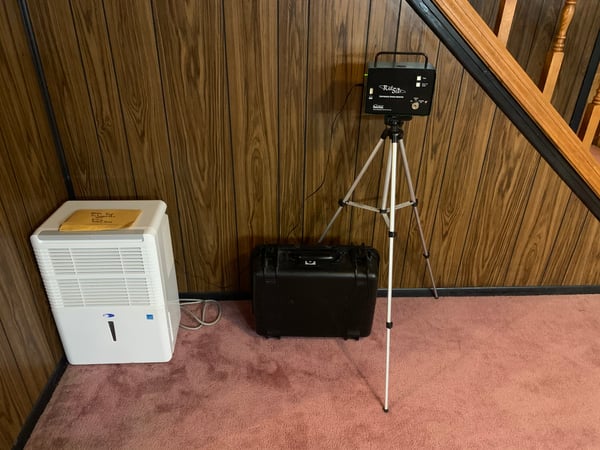Radon is the second largest cause of lung cancer in the United States. As a result, it is essential to understand what it is, why it's dangerous, and what you need to do if you ever show the signs and symptoms of radon gas poisoning.
In the article below, we'll talk about what radon is, its exposure signs and symptoms, what to do if you think you've been exposed, the radon testing process, and what you can do to protect your family from the dangers of radon.
Knowing what radon is and staying informed about the symptoms of radon gas exposure is the best way to keep you and your family safe and prevent exposure.
Table of Contents
- What Is Radon?
- How Are You Exposed To Radon?
- What Are the Symptoms of Radon Exposure?
- What To Do If You Notice Radon Symptoms
- Testing Your Home For Radon
- What To Do If You Have A High Radon Level
- Contact A Professional Radon Company
What Is Radon?
Radon is a naturally occurring radioactive gas.
It's colorless, odorless, and tasteless, and completely undetectable to humans.
It's produced from the breakdown of uranium in the soil and rocks in the earth.
Your home might have elevated levels of radon if it was built on soil with natural uranium deposits.
Outdoors, radon gas is relatively harmless.
However, when you breathe in high radon levels indoors, it can get into your lungs and expose you to small amounts of radiation.
This can very easily damage the cells in the lining of your lungs and increase your risk of lung cancer.
The longer you live in a radon-contaminated house, the higher your risk is for lung damage.
Matters are even worse for smokers. Unfortunately for smokers, exposure to radon gas creates a greater risk for lung cancer than either factor alone.
How Are You Exposed To Radon?
You're exposed to radon when you breathe it in.
You can be exposed to high amounts of radon in your workplace, school, or any other building.
Most of us spend a majority of our time inside the house, so that's where radon exposure is most likely.
Radon can enter your home through foundation cracks in your basement or cracks in floors.
Once the radon gets in through the cracks, it can get trapped inside and build up to unsafe levels.
There is the potential for other types of exposure. In some cases, radon can also get into your well water. It can even be found, very rarely, in building materials. However, it's mostly a threat when it's inhaled.
Radon exposure can happen in any home, whether it has a basement, crawl space, or just built on a concrete slab.
Radon is more likely to accumulate in homes that are very well insulated, tightly sealed, or located in an area where soil contains a lot of uranium, thorium, and radium.
It's estimated that about one in every fifteen homes has dangerous levels of radon.
The highest concentrations of radon tend to be found on the lower levels of the home.

What Are the Symptoms of Radon Exposure?
Radon poisoning is an insidious disease. It takes time for any evidence of the sickness to appear. As a result, you won't have radon poisoning symptoms right away.
Instead, radon symptoms build up over an extended period. Health problems from the exposure, such as lung cancer, will show up after many years.
Radon symptoms are often the same as symptoms of lung cancer.
Signs of lung cancer from radon exposure can include:
- Wheezing
- Shortness of breath
- Coughing up blood
- Chest pain
- Persistent cough
- Hoarseness
- Frequent infections like bronchitis and pneumonia
- Loss of appetite
- Weight loss
- Fatigue
Unfortunately, there are no medical tests that can tell if you have radon gas poisoning. Even if there were, there aren't any treatments that will clear it from your body.
That's why it's crucial to have your home tested. Once radon poisoning symptoms show up, it's usually too late.
For more information read our blog post: "Why is Radon Dangerous at High Levels?"
What To Do If You Notice Radon Symptoms
Radon exposure can lead to severe health risks, so it's vital to visit your doctor at the first signs of radon poisoning.
Since radon gas breaks down so rapidly inside the human body, there currently aren't any tests that can detect the presence of radon in your system.
Since there are about 21,000 radon-related lung cancer deaths annually in the United States, when you visit your doctor, you will likely be evaluated for the presence of lung cancer.
If you believe your home has elevated levels of radon gas, you must contact a radon mitigation company to analyze your home's levels.
If your home tests positive for elevated radon levels, they can install a radon mitigation system to lower your levels and limit you and your family's exposure to the harmful gas.
Testing Your Home For Radon
It is imperative that you have your home tested for Radon.
Even if your neighbor's radon test came back clear, levels can vary from one home to the next.
The only way you can know for sure that your family isn't being exposed to radon is to have your home tested.
You can do this on your own, but most people get the help of a professional radon testing company.
Short-term Testing
If you're in a hurry and need quick results, like during a real estate sale, you can use a short-term test.
These tests can measure radon for just 2 or 3 days, while some can measure up to 90 days.
During a short-term test, you need to keep your windows and doors closed as much as possible and avoid fans that bring in air from the outside.
Long-term Testing
If you have the time, you should choose a long-term test.
Since radon levels fluctuate from month to month and even day today, you'll get the most accurate results from a long-term test.
Long-term tests measure radon levels for more than 90 days.
Long-term radon tests are relatively inexpensive and simple to use, and they can be found at most hardware and big-box stores.
To ensure accurate results, you need to follow package instructions carefully.
Your Radon Eliminator testing specialist should place your test kit in the basement or lowest level of your home.
Once the kit is in place, there's nothing else you need to do.
Once the test is complete, you need to pack it up as instructed and send it back for analysis.
You should have your results within a few weeks.
Or, you could have a professional testing company come in and perform the test for you to ensure accurate results.

What To Do If You Have A High Radon Level
Radon levels are measured in picocuries per liter, or pCi/L. Levels of 4 pCi/L or higher are considered hazardous.
If your home has levels above four pCi/L, you'll need a radon mitigation system installed.
Radon mitigation systems typically include a vent pipe that runs through an attic to release radon gas above your home.
A radon mitigation system installed by a professional mitigation company can reduce levels in your home up to 99 percent.
Professionally installed mitigation systems typically cost around $1,200 to install, but they are well worth the investment when considering what radon poisoning can lead to.
And many people assume that if their basement has elevated radon levels, they can just avoid their basement to lower their risk of exposure.
But that's not always true.
If your HVAC system and return ducts are located in your basement, radon will circulate through your entire home when the system is running.
Contact A Professional Radon Company
If you are worried about the radon in your house, or if you've noticed signs of radon poisoning, you need to go to the doctor.
Then you need to contact an experienced mitigation company to get your home tested for radon.
Radon Eliminator can reduce radon levels and is rapidly becoming one of the largest and most respected Radon Mitigation Service Providers in the State of Ohio.
Radon Eliminator uses state-of-the-art radon testing and removal equipment to serve each one of its customer's unique challenges.
To make sure your home doesn't have a radon problem, contact Radon Eliminator to test it.
If a problem is found, they will fix it.
Click the button below to schedule a test and mitigation.





